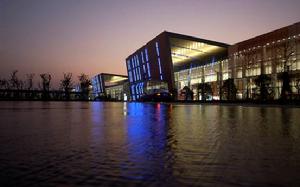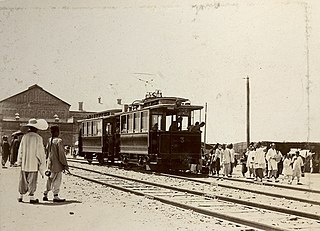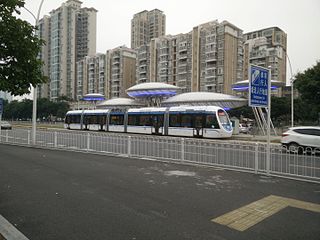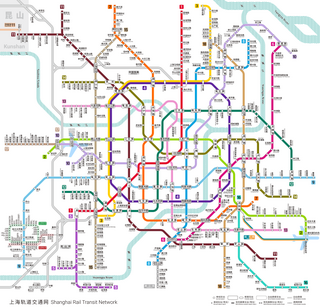
Line 2 is an east–west line in the Shanghai Metro network. With a length of nearly 64 km (40 mi), it is the second longest line in the metro system after line 11. Line 2 runs from East Xujing in the west to Pudong International Airport in the east, passing Hongqiao Airport, the Huangpu river, and the Lujiazui Financial District in Pudong. With a daily ridership of over 1.9 million, it is the busiest line on the Shanghai Metro. The eastern portion of the line, from Guanglan Road to Pudong International Airport, was operated almost independently from the main segment until April 19, 2019, when through service began. The line is colored light green on system maps.

The Nanjing Metro is a rapid transit system serving the urban and suburban districts of Nanjing, the capital city of Jiangsu Province in the People's Republic of China.

Urban rail transit in China encompasses a broad range of urban and suburban electric passenger rail mass transit systems including subway, light rail, tram and maglev. Some classifications also include non-rail bus rapid transport.

The Shenyang Metro is a rapid transit system serving the city of Shenyang, Liaoning, China. It's the seventh operational subway system in Mainland China and the first in Northeast China.

Line 10 is a southwest–northeast line of the Shanghai Metro network that opened for service on April 10, 2010. The line runs from Jilong Road to Hongqiao Railway Station, with a branch line from Longxi Road to Hangzhong Road. It has been given the unofficial nickname “Golden Line” as it links many of the city's tourist attractions like Yuyuan and Xintiandi. It connects the Hongqiao International Airport with the downtown core of Shanghai, and also the dense residential districts of Yangpu and Hongkou. It is the only line in the system with numbered station codes. It is the first high-density and high-volume fully automatic subway line in Mainland China, operating with GoA4 unattended train operation. The line is colored lilac on system maps.

Nanjing International Expo Center is an exposition center and also a landmark in Nanjing, Jiangsu Province, China. It has an exposition area of 120,000 square meters. The Expo Center facilities include six exposition pavilions, 38 conference rooms and a multi-function pavilion, and it is capable of hosting exhibitions with over 4,500 international standard large-scale exhibition booths. Two more exposition pavilions, a business hotel and a conference center hotel are planned.

The earliest tram (有轨电车) service in Beijing dates back to 1899, and trams were the main form of public transit from 1924 to the late 1950s before they were replaced by trolleybuses that follow the tram routes they replaced. However new tram services are being introduced in Beijing's suburbs.

Yuantong station is an interchange station between Line 2 and Line 10 of the Nanjing Metro. The Line 10 station began operations on 3 September 2005 as part of Line 1's Phase I that ran from Maigaoqiao to Olympic Stadium, while the interchange with Line 2 opened when that line opened on 28 May 2010. On 1 July 2014, with the opening of Line 10, the former branch of Line 1 from Andemen to Olympic Stadium became re-designated as Line 10.

Several cities in China had tram systems during the 20th century; however, by the end of the century, only Dalian and Changchun remained extant. However the 21st century has seen a resurgence in tram transport systems as China attempts to combat with urban traffic congestion and pollution. According to an expert affiliated with the Ministry of Transport, some of the newly constructed tram networks were built without considering the suitability of this mode of transportation well, leading to low-passenger numbers due to the tram lines serving less-densely populated outskirts, slow operating speeds and with unrecoverable operating costs.

Shenzhen Tram is a light rail system consisting of two tram routes in Longhua District, Shenzhen, Guangdong, China. Construction commenced on 27 December 2013 and public testing started on 30 June 2017, with the system fully opening on 28 October 2017. The tram system integrates the north side of Longhua into the city's rail network and is expected to significantly ease commuting difficulties.

Nanjing tram is the tram system of Nanjing city in the province Jiangsu of the China. There are two lines which are not connected to each other.

The Zhuhai tram network was a light rail system serving the city of Zhuhai, Guangdong, China. The first section of Line 1 started trial operation on November 7, 2014 with the full line scheduled initially to open by August 2015 and finally opened on 13 June 2017 and runs from Haitian Gardens to Shangchong. However, facing the problems of frequent breakdowns and low passenger flow, the operation of Zhuhai Tram Line 1 was never carried out smoothly and the Government decided to stop its operation in January 2021 and then to dismantle it in May 2024.

Suzhou SND Tram is a tram system in Suzhou New District, Suzhou, Jiangsu, China. The tram uses an overhead catenery system. Suzhou Tram started construction on September 11, 2012 and was opened on October 26, 2014. There is currently two lines in operation in the Suzhou New District. The Suzhou High-Tech Rail Tram Limited was established in April 2011, and the tram line was approved by the Suzhou City government June the same year.
Trams in Wuhan may refer to any one of the tram systems currently operational in the city of Wuhan, Hubei, China. The first tram started revenue service in Wuhan is the Auto-city T1 Line, which began on July 28, 2017. Subsequently, Optics Valley tram started revenue service from April 1, 2018.

Songjiang Tram is a light rail tramway in Shanghai, China. The system consists of two lines totaling 31 km (19 mi) with 42 stations. Unlike the Zhangjiang Tram, Songjiang trams use centenary power supply and steel-wheeled rail systems. Most of them use independent rights of way. The intersection signal lights were adjusted through the system to make them pass first, and the running speed reaches 25-30km/h. Trains run from 6:00 till 22:00. With further extension of the network public transport modal split in Songjiang is expected from the current 23% to 40%.

Yizhuang T1 Line is a 13.255 km (8.2 mi) tram line with 15 stations. It is part of the Beijing Subway system. It runs from Quzhuang station in Daxing District to Dinghaiyuan station in Tongzhou District. The line opened on December 31, 2020. Laoguanli station will open in 2024.

Shanghai Rail Transit includes all rail transit lines operating in Shanghai, mainly composed of High-volume railway system, Low-to-medium-volume railway system and Maglev system. The system was established on May 28, 1993, when Shanghai Metro Line 1 opened.

The Lingang Medium Transport Volume, also known as Lingang Digital-rail Rapid Transit, is a rapid transit system operating within Lingang in Pudong District, Shanghai, China. It started operations on 30 June 2021, and is operated by the Shanghai Lingang Public Transport Company. The system operates as an Autonomous Rail Rapid Transit (ART) system, but conventional bus rapid transit-specification buses currently run on the system too.


















